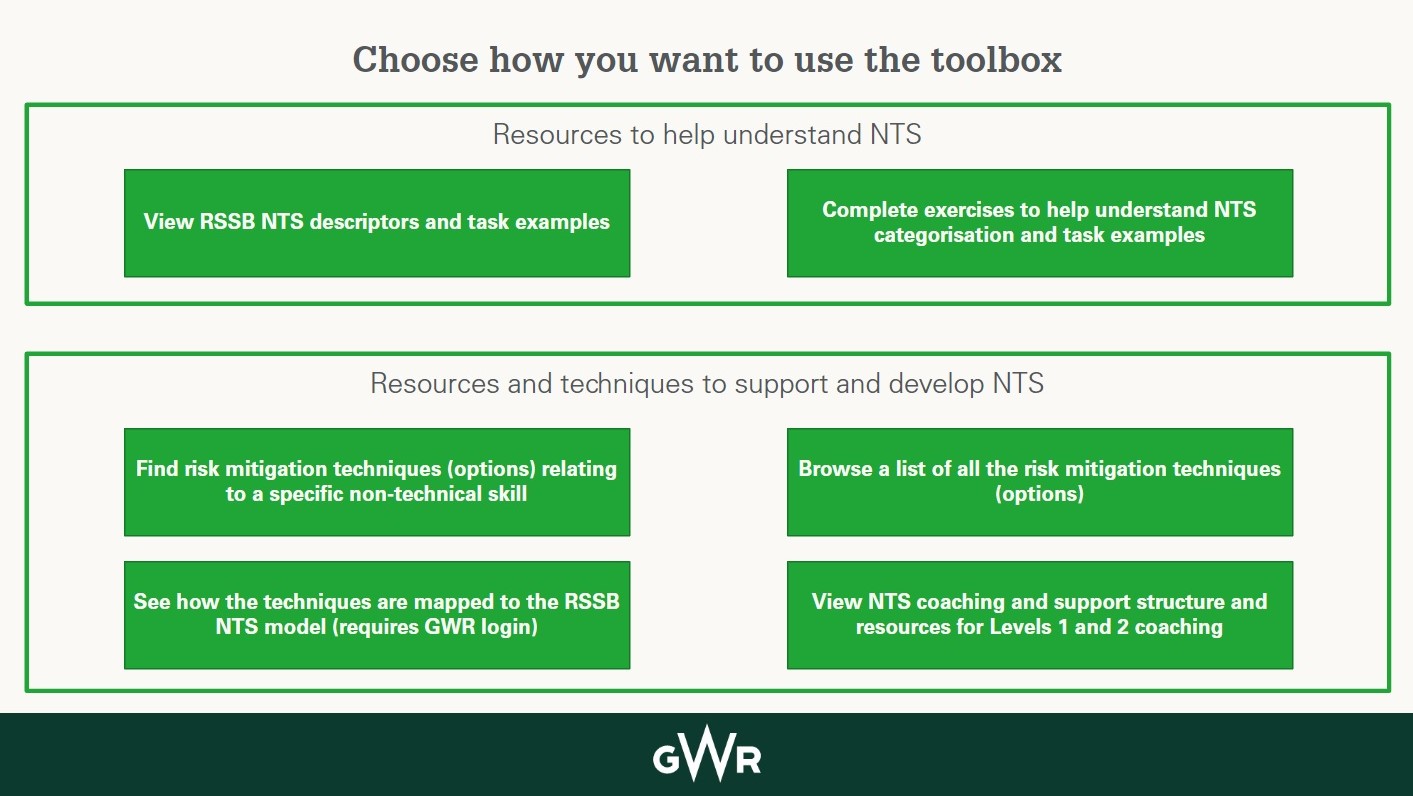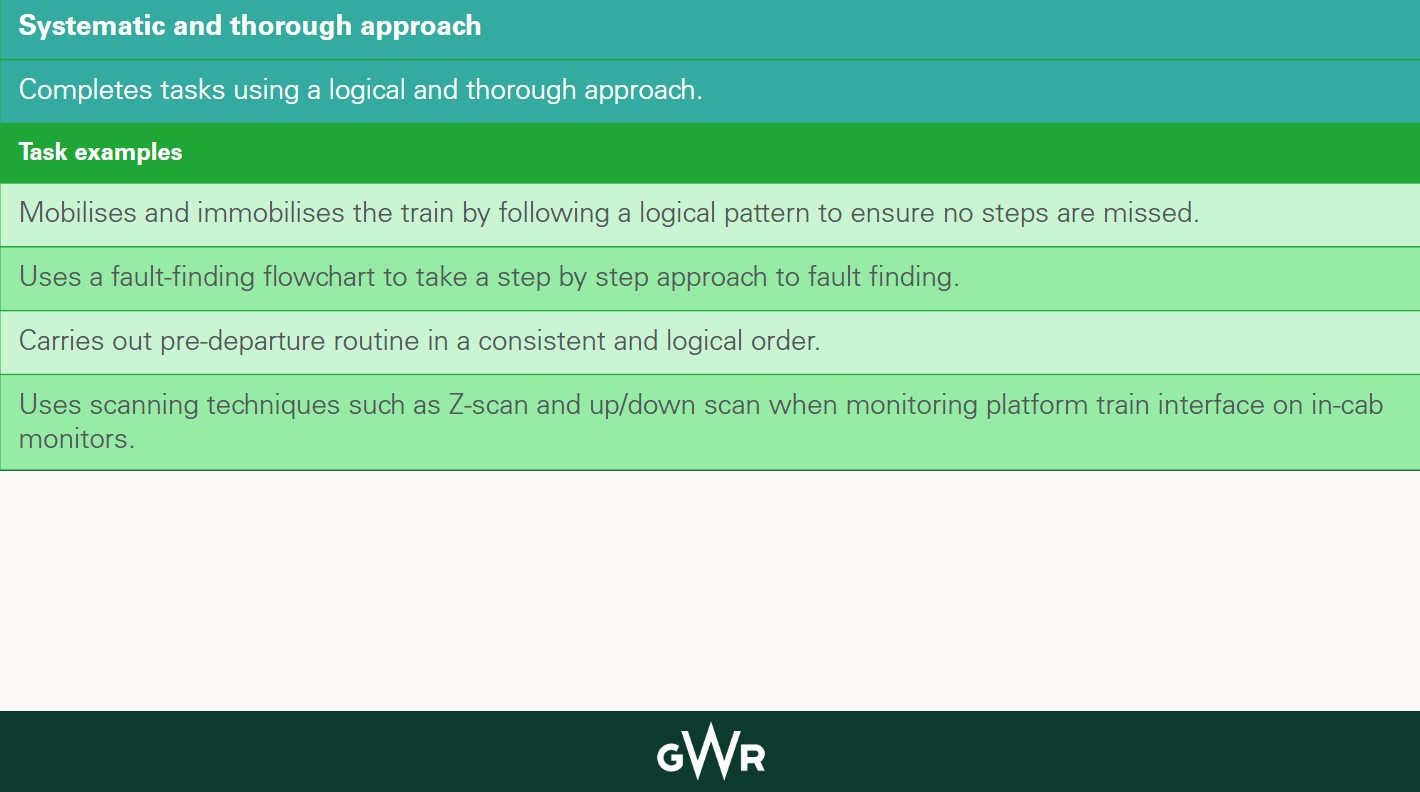Case Study: Great Western Railway – Developing NTS learning resources for frontline staff
Why did GWR create this?
GWR had an existing guide to developing NTS for managers and their candidates. It was known informally as the ‘Green Book’, and it consisted of a list of practical techniques for applying NTS. These were aligned with the original version of the RSSB NTS framework from 2012. Many managers had said they liked the Green Book because it made the topic of NTS more tangible and provided a ‘menu of answers’. Some operational staff also said that they liked this guide.
GWR decided to build an NTS toolbox as a successor to the Green Book. The aims were to:
- Update the content of the Green Book.
- Make it a more user-friendly and interactive learning resource to allow everyone to use it.
- Promote personal ownership of NTS learning and development using a coaching approach. This is instead of a top-down approach from management.
- Make NTS more transparent and support a fair culture.
- Support standardisation of NTS across GWR as part of a programme for operational managers, starting with driver-competent managers, to standardise the approach to NTS materials.
What’s in the NTS toolbox?
GWR used the updated RSSB NTS framework: Categories, skills and descriptors to structure the toolbox. The GWR NTS toolbox contains practical techniques, mapped to the RSSB NTS framework, to support drivers’ competence. Both managers and drivers can use it.
The NTS toolbox allows the user to ‘Choose how you want to use the toolbox’. All of the options are designed to reinforce the idea that NTS are always used in relation to technical tasks rather than thought of in isolation. The structure of the toolbox is shown in Figure 1.
Figure 1 Structure of the GWR NTS toolbox

The ‘Resources to help understand NTS’ section contains links to allow users to explore information about the NTS categories, skills, descriptors, and task examples to help them understand the skills in the framework. For example, if users want to know about a particular NTS, they can read the RSSB NTS task examples for that skill to help them understand it better (see Figure 2).
Figure 2 GWR’s driver task examples for the ‘Systematic and thorough approach’ NTS

Users can also complete exercises to sort the NTS according to the NTS categories and identify the most relevant NTS to a task example. If the user mismatches skills and categories, they are prompted to look at the relevant NTS descriptors.
The ‘Personal safety strategy techniques to support and develop NTS’ section contains links to allow users to explore information on risk mitigation techniques (or personal protection strategies) that they can apply on the job. They can do this by browsing the risk mitigation techniques or selecting a particular NTS and finding all the techniques linked to that skill.
The risk mitigation techniques presented in this section were collated from:
- the Green Book
- RSSB’s Driver and shunter NTS strategies
- RSSB’s Underload Toolbox
- RSSB’s safety-critical communications training
- other anecdotal strategies gathered within GWR.
An advantage of the e-learning platform is that allows the addition of different media. This means some personal safety strategy techniques have links to media. For example, the page on the short journey concepts has the relevant section of the RED 40 ‘Driving at Caution’ video embedded.
How did GWR develop this?
The NTS toolbox has been developed as part of GWR’s Everyday NTS programme. This aims to reinforce the idea that NTS allows drivers to evaluate their performance every day. For example, they can ask themselves:
- What went well today?
- What could I have done to perform better?
- What could I do next time?
They can use the toolbox to identify actions the driver could take that would help them next time.
The Everyday NTS programme has a steering group and a working group, including a mix of trainers and managers. While the toolbox was being designed, these colleagues provided useful feedback on what worked and what didn’t work, as well as feedback on the look and feel of the toolbox.
How did the RSSB NTS materials help?
The RSSB NTS materials helped give a structure to the toolbox, as the new and existing risk mitigation techniques could be mapped to the framework. The updated NTS framework supported GWR to:
- Use NTS in a more practical way.
- Simplify the way the information was presented.
- Aid people in better understanding the NTS categories and skills.
What are the next steps?
Following piloting, the Everyday NTS programme is being rolled out to driver-competent managers. The aim is to give them confidence to use the toolbox to provide NTS coaching to drivers as part of informal coaching conversations, competence assessments, and competence development support following incidents. The NTS toolbox has been introduced to them in a formal learning environment, and the goal is for them to access it in a non-formal, just-in-time way.
Longer term, GWR are planning to create task examples for other safety-critical roles, including guards, shunters, and dispatchers.

